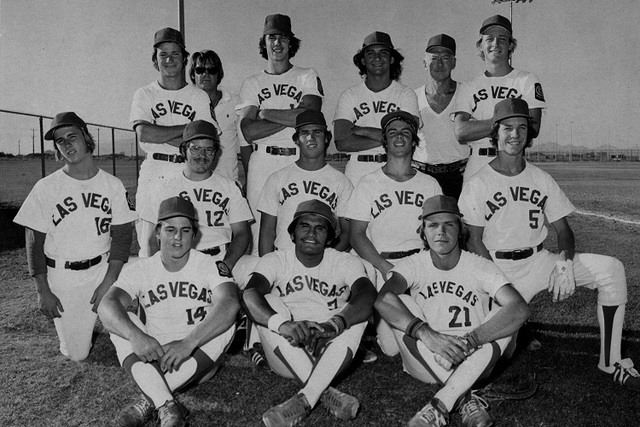Summertime baseball: runs, hits, errors … and memories

It begins today for the Mountain Ridge Little League kids in Williamsport, Pa. The runs, hits and errors — hopefully, not too many errors — that will produce a lifetime of memories. Baseball is known for making memories, even for those who don’t make it to the World Series.
Kurt Garehime was on the first Las Vegas Little League all-star team, in 1968. That team, like all the others from Nevada before the Mountain Ridge kids, didn’t make it to Williamsport; it lost to the team from Reno that had Glenn Carano.
This was before he was Glenn Carano, Dallas Cowboys (and Pittsburgh Maulers) quarterback. Then, he was just Glenn Carano, a 12-year-old pitcher “with a hellacious curve” according to Kurt Garehime.
Six years later, Garehime played center field for the Post 8 American Legion team. He was the Most Valuable Player of the league. Post 8 didn’t make it to Roseburg, Ore., site of that year’s Legion World Series. It had just 12 players — 10 from Las Vegas High, a couple from Bishop Gorman. But it beat Post 51, mostly Rancho kids, for the summer baseball state title in 1974.
The Rancho team was loaded. It had Marty Barrett, who struck out only 209 times in 3,378 major league at-bats, who collected 24 hits in the 1986 playoffs and World Series for Boston. Post 51 also had John Huntington, Dave Beall, Craig Sibley, Jeff Wolfe. Those guys were excellent ballplayers, too.
Post 8 had Garehime, Glenn Page, Terry Holden, Tim Lewis, Steve Davies, Nick Trujillo. Most of those guys played college baseball. It had Ed Rogich, whose father, Ted, was a local American Legion pioneer; whose brother, Sig, helped get a couple of presidents (Ronald Reagan, George H.W. Bush) elected as a political consultant.
But Post 8 also was a star-crossed team.
It had a kid named Jimmy Dyer at shortstop.
Dyer was spiked in the first inning of the first game of the regionals up in Yountville, in California’s wine country. That was a big reason Post 8 didn’t make it to Roseburg, Ore., 40 years ago.
In 1975, Jimmy Dyer was selected by the White Sox in the first round of the regular phase of the Major League Baseball Draft out of Arizona Western College in Yuma; in June, he was picked by the Mets in the second round of the second phase. He would sign with the Mets.
“Baseball has come a long way in Southern Nevada,” Ed Rogich said. “Marty Barrett stands out as probably the best ever (during the 1970s) but Jim Dyer could have been as good as Marty in the bigs, had he lived.”
Had he lived.
Jimmy Dyer contracted a rare form of cancer and died when he was only 22.
“Jimmy was a natural,” said Rogich, who played first base on those teams and went on to become a gaming executive.
“He and Marty stood out as two that just did stuff naturally that most of us would never achieve. Marty pulled off hidden ball tricks; Jimmy made plays that were impossible. They were both magical infielders. They say Jimmy was destined to be the next Mets shortstop …
“He was buried in his (Jackson) Mets uniform.”
Kurt Garehime was Jimmy Dyer’s best friend on Post 8.
‘Defensively, Jimmy was very, very special,” said Garehime, who was teammates with Barrett and former big-leaguers Mickey Hatcher and Hubie Brooks at Mesa (Ariz.) Community College and now owns a successful beauty supply business.
“I’ll tell you how good he was: His senior year, he hit .100 (Dyer’s father, Ben, wanted Jimmy to be a switch-hitter, so he batted mostly left-handed) and he was still voted all-state at shortstop.
“He had remarkable talent. He played only one year of football, his senior year, and I believe he was second team all-conference; he was a starting guard on the state championship basketball team. He was a marvelous piano player. He had beautiful hands.”
Jimmy Dyer could field a baseball like Luis Aparicio, and he could play Duke Ellington on the piano, and he could play boogie-woogie, too. That’s a combination one just doesn’t come across very often.
“But of all those skill sets, he was probably a better person,” Garehime said.
“That’s probably the most painful thing for all of us when we look back at Jim. He was such a special guy, such a good-hearted person, such a warm individual.
“Was he as good as Marty? No. Marty was the smartest player on the field. But Jimmy was extremely special.”
When a story in the newspaper about the resurgent Rancho team’s run to this year’s American Legion regional finals slighted Post 8 when referencing the glory days of Las Vegas baseball, Ed Rogich sent a nice note to set the record straight.
He attached a newspaper clipping from Post 8’s 13-6 victory over Post 51 in the state championship game and a photo of the 1974 regional qualifiers, among the first teams from Las Vegas to make it that far.
You can see the high stirrups.
You can see Ben Dyer, assistant coach, in the back, wearing a V-neck T-shirt. His son Jimmy, the natural, the kid with the beautiful hands, is standing next to his old man, sporting a major smile.
This is how Kurt Garehime remembers his baseball pal. And every now and again, when he’s riding in an elevator or having dinner or something, and Duke Ellington’s “Satin Doll” begins to play in the background, he thinks of Jimmy Dyer and gets misty-eyed, because Jimmy loved to play that song on the piano.
Las Vegas Review-Journal sports columnist Ron Kantowski can be reached at rkantowski@reviewjournal.com or 702-383-0352. Follow him on Twitter: @ronkantowski.